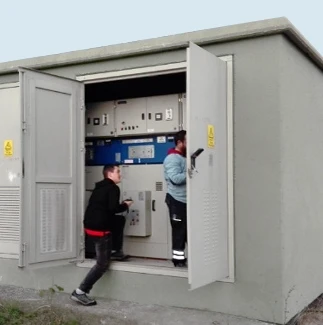
Secondary substation MV/LV
it is a facility for medium voltage to low voltage transformation for end consumer needs. The low voltage level is divided to independent branches for groups of end consumers.The design on secondary substations (SS) may vary, like cabinet and transformer fixed on pole, metal container, concrete skeleton or underground realization in existing buildings. According to the network location, SS can be node, loop or end type.
Ring Main Unit (RMU)
Ring Main Unit is switchgear in metal enclosure usually used in medium voltage distribution networks of ring topology. It is equipped with several switches for individual feeders load connection.
Note: ELVAC is a producer of monitoring and controls systems for secondary substations and ring main units. We do not produce the secondary substations and ring main units itself.

Description of the situation
With the gradual development of automation in distribution networks, automation is constantly being improved on SS as well. Through these investments, power distribution companies get information about larger part of the network, from the substation to the end user. After initial investments to the automation on the primary sides of SS (MV level), LV level is also monitored. The breakthrough came mainly with the connecting of increasing number of renewable energy sources and further development of Smart Grids. Another developing areas became Power Quality Metering, Smart Metering for remote power consumption and power production monitoring, or Self Healing Grid, where automation functions are used for automatic network reconfiguration during failure on lines to minimize the number of affected consumers.
The power lines on MV level can be overhead wires or underground cables. In case of overhead power lines, which are more sensitive for environment, it is recommended to measure both voltage and current for the purpose of evaluation of faults on lines. In case of cable networks, it is assumed, that the voltage is quite stable variable, therefore faults on lines can be detected only via current measurements. This solution is then much cheaper, because voltage sensors are quite expensive. If SS is in important location, it is also used the voltage measurement on MV level for the purpose of directional detection of faults, which is useful also in situations, when renewable energy sources are connected in the network or the distribution node or loop can be powered from more sides. There is possible also a compromise solution, where the voltage is measured on the bus ones for all outlets and the currents are measured at each outlet. This solution requires the system, where the voltage information can be distributed for the calculation of power (active, reactive, apparent) at individual outlets.
We can encounter overhead and underground cable lines also on LV level. Individual branches are usually protected by fuses and these fuses can be also monitored. If there is some LV power source in the network, the solution must detect the status of fuse, even if the voltage is on both sides.
our solution
ELVAC RTU solution
The increasing demands of energy operators on the functions of RTU systems (Smart Grid, Self Healing Grid and Power Quality Metering), the variability of inputs and outputs and the processing of a larger amount of data have led to the fact that modular RTU systems are mainly used in these applications. ELVAC RTUs offer:
- communication with SCADA using various communication protocols, including secure communication and communication tunnels,
- optional simultaneous multi-channel communication, for example backup communication with SCADA system or for service purposes,
- data collection from switching element and alarms (doors, etc.),
- remote control, system setup and firmware update,
- measurements on the primary and secondary side of transformer,
- fault indication, protection relay functions (current, voltage, frequency).
- automation functions for Smart Grid and Self Healing Grid,
- optional power quality measurement,
- waveform recording of faults on lines and remote download,
- integrated backup battery charging and testing,
- integrated HMI in RTU.